This is the sixth post in a series of Nikon D850 tests. The series starts here.
I decided to do my downhill-with-a-tailwind test for autofocusing accuracy on the D850 with the Nikon 105 mm f/1.4 lens. This test uses a static flat, easy-to-focus-on target and bright light (in this case, f/1.4 at 1/800 seconds at ISO 64).
Here’s the setup:
The camera is on the right, mounted to an Arca Swiss C1 which is mounted to the camera stand. The wire to the Nikon remote snakes across the frame. The remote itself is resting on the top of the copy stand main pole. The target is the letter size print with the two black rectangles and the Siemens Star in the center. The star was centered, and the focus point set to the center, where it almost covered the star.
I made three sets of exposures:
- EFCS, MUP (PDAF)
- EFCS, Liveview (CDAF)
- Electronic shutter, Liveview (CDAF)
Here’s the rest of the protocol:
- ISO 64
- AF-S
- Release priority: focus
- Aperture exposure mode
- f/1.4 through f/11 in whole stops
- 32 exposures at each f-stop
- Wescott LED panels set to 5500 K.
- Target distance at the center of the rial, 3 m.
- NEFs exported as TIFF mosaiced file in dcraw (document mode)
- TIFFs cropped and raw channels selected in Matlab program
- MTF50 of cropped TIFFs measured with MTF Mapper
- Data assembled in Matlab
- Data plotted in Excel
The results, for one of the green raw channels:
As the caption indicates, this is using Mup mode, but not liveview, so we’re using the phase-detection autofocus (PDAF) capability of the D850.
The vertical axis is MTF50, measured in cycles per picture height (cy/ph). I plotted the average of the 32 images, the average plus the standard deviation (aka sigma), and the average minus sigma. I also plotted the best and the worst results of each 32-image set.
Now let’s look at the two live view plots:
You can see that the PDAF doesn’t do very well wide open when compared to the CDAF. This may be because the calibration of the lens to the camera is imperfect. But I don’t think so because the PDAF is slightly better than the CDAF at f/2 and f/2.8. You can also see that whether you use the EFCS or the electronic shutter makes little difference. Take a look here to see how these results compare with manual (or robo-manual) focusing.
This is a pretty darned good performance in terms of the spread of the results. Whether it’s good in comparison to what we’d get if the lens were focused perfectly is unknown at this point. I’ll consider doing some more testing.
Now let’s look at the red raw channel:
It’s pretty clear that the lens has a lot of longitudinal chromatic aberration (LoCA), and that the PDAF at f/2 and f/2.8 is optimizing for the green channel, while the CDAF is aiming more for a blended optimum. I like making the green channel as sharp as possible, but there are arguments in both directions.
Here are the blue channel results:
Pretty similar to the green channel results.
In a comment to this post, Horshack asked to see the data for each exposure. Here it is for the four widest f-stops:
You can see that at f/1.4 and f/2, the PDAF tends to get stuck in a rut; where it’s focused when the shutter release is depressed influences where it’s going to end up. That probably explains why, once it’s in that rut, that it’s more consistent than the CDAF, which you can see starting over if you look at the live view display when the sequences are running. To see what happens when the PDAF system is forced out of its rut, look here.
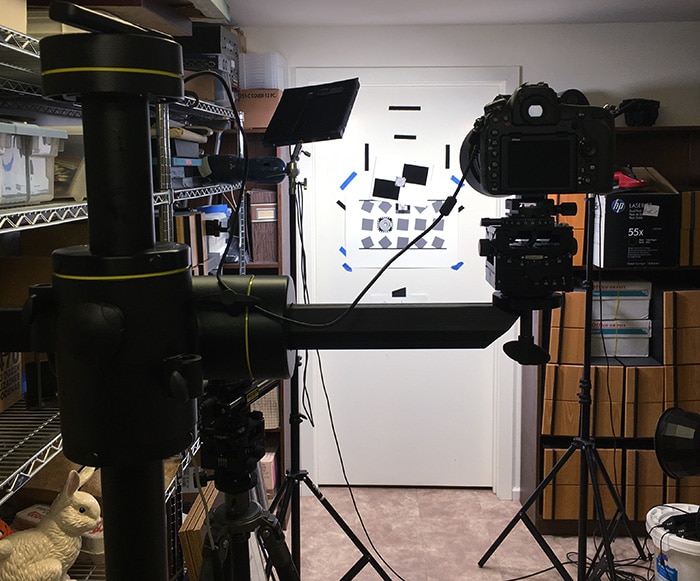
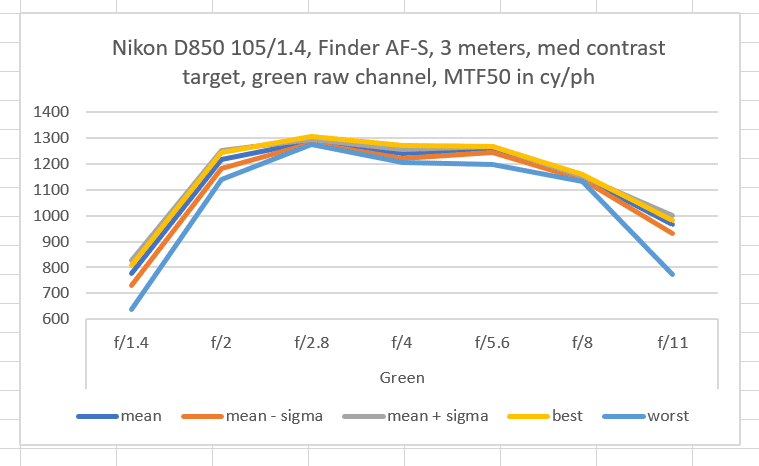

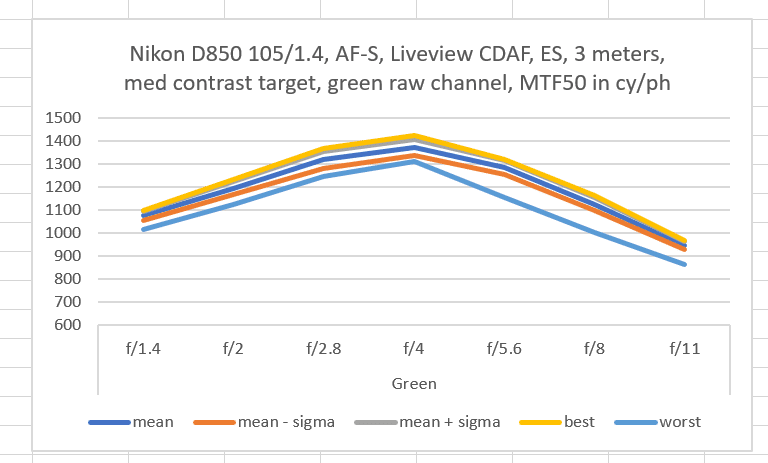

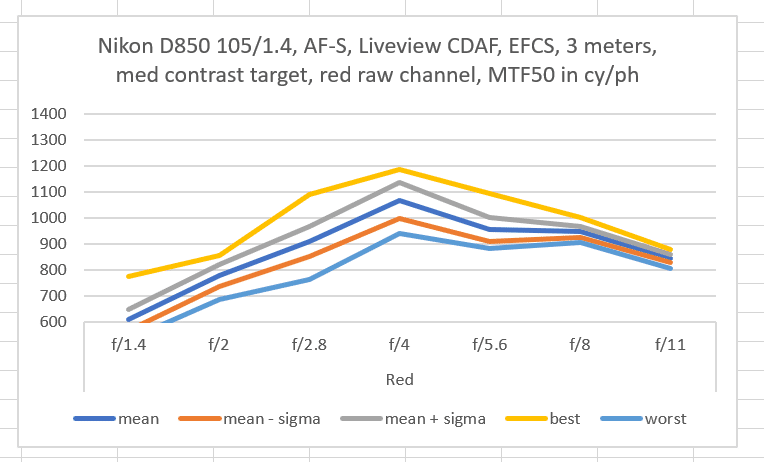
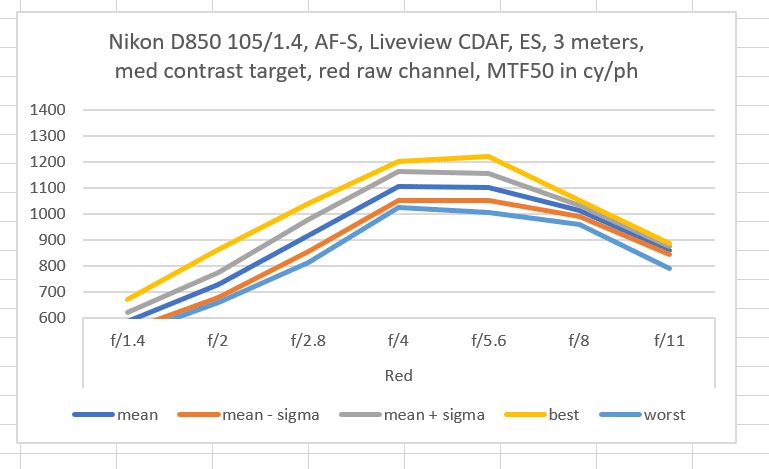
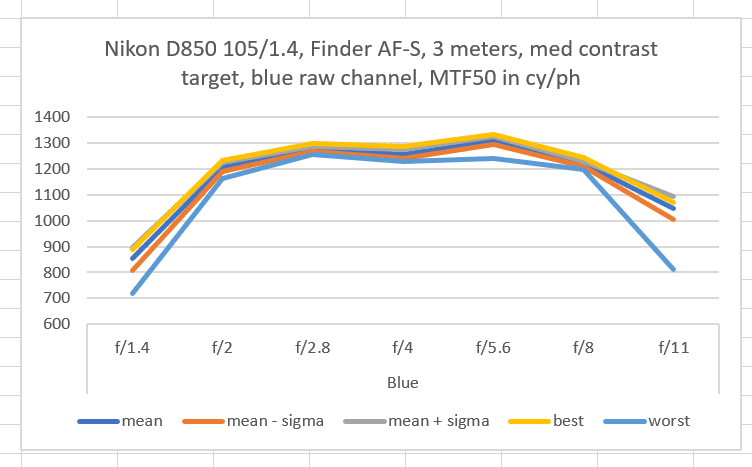
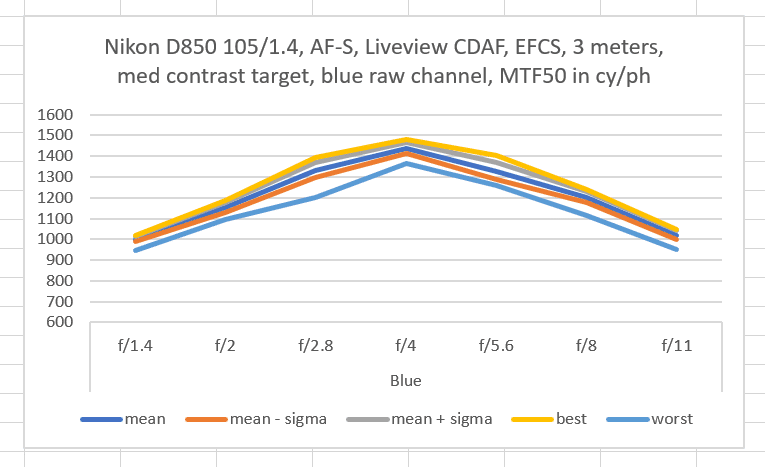
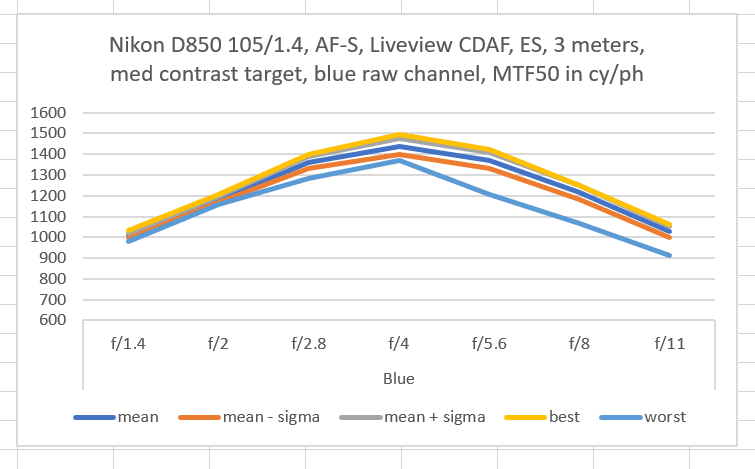

Really interesting (but not unexpected) how the CDAF accuracy is possibly sensitive to diffraction at smaller apetures.
CDAF didn’t do materially worse — or better — than PDAF at f/11…
Is this due to focus shift?
Is what due to focus shift? I haven’t measured the focus shift for the 105/1.4 — yet.
Allow me to complete my question:
Is the dropoff in center resolution at f/4 in PDAF due to focus shift? Photozone’s review indicates that it has a good deal of focus shift.
Perhaps at wider apertures it’s focused dead-on, at f/4 the focus shifts too far back, and at f/5.6 the depth of field covers the defocus.
Jim,
I checked this out to be sure but when I noticed your numbers were low. I went and checked the issue of cropping before an MTF measurement in Imatest. Not sure if you have the same issue in your software or are still using Imatest but cropping before measuring does impact the Imatest score.
I did a file at full resolution and the cropped the same at 4128 pixels. The cropped version was appx half the MTF of the full sized version.
Anton
As I described in the protocol, I’m using MTF Mapper. And screwing up the conversion from cy/px to cy/ph is a rookie mistake. Did you notice that I was measuring raw planes?
My results are in cy/px. How do I send you a file? jim@kasson.net no longer works.
Look for an email from me. [Update: email bounced with text: “host gmail-smtp-in.l.google.com[74.125.28.27] said:
550-5.1.1 The email account that you tried to reach does not exist.”]
If you’re looking at cy/px, then it doesn’t matter what the image is cropped to.
Excellent work Jim. It would be interesting to see a scatter plot of all 32 exposures/measurements for a given aperture, say f/1.4. That would give readers a visual depiction of the std. dev., as well reveal any temporal correlations between measurements (ie, see if below or above mean AF cycles happen in clusters).
Good idea. I added a graph to the bottom of the post.
Great, thanks Jim. The f/1.4 and f/2 PDAF trends are interesting. Was focused racked in between each exposure? (apologize if you covered this but couldn’t find it in the notes of the article)
No. CDAF does this by itself. PDAF on the D850 apparently doesn’t.
I agree, CDAF racks as a function of its maximum-contrast seeking algorithm. Without racking focus the PDAF results may be more a reflection of Nikon’s focus re-seeking algorithm than a measure of its shot-to-shot precision – I suspect the phase differential for an in-focus shot (after first AF acquisition) will be small enough to prevent subsequent AF cycles for most of AF invocations. Perhaps a retest sample (say at @ f1/.4) with racking would be helpful (for both summary graphs and the scatter graph).
Could the PDAF sensor be less sensitive to oblique light and hence actually only getting in light from F2 onwards (ie the micro lens is effectively an aperture).
I’m no expert, but I thought PDAF effectively worked at a constant aperture. Something around f/5.6?
I believe that is more of a limitation that it won’t work over 5.6 as the camera open up the lens to focus (except Sony). In fact there are many complaints complaing how focus speed is reduced stopping down on the Sonys and Canons dual pixel certainly works wide open. There no hard data out there though but how would the camera achieve the effective f5.6 as the phase detect senor looks stanard and there is nothing stopping down the light. F2 is believable for FSI with non shifted micro lenses but I think F5.6 is extreme. Either way its going to make accurate focusing at F1.4 difficult even with software adjustments for focus shift.
Ok I just saw your latest post and the link to Marianne work. So it is effective F5.6 and software is accounting for focus shift difference (can’t believe they only did that from 2014 that should have been possible 15 years ago). I imagine there is a similar issue with Canon as there are many complaints about AF misses on their F1.2s.